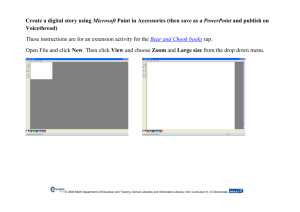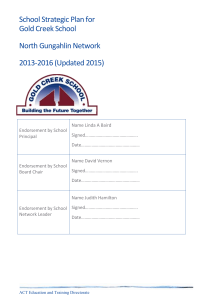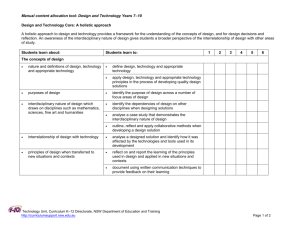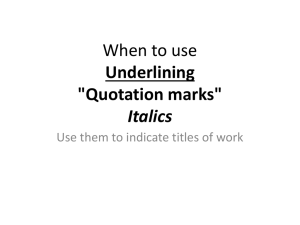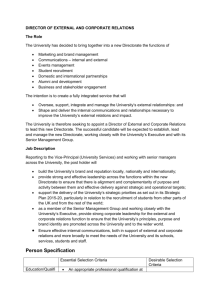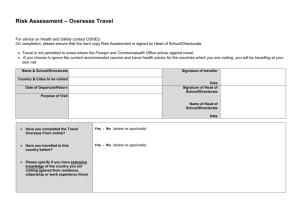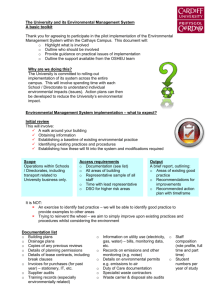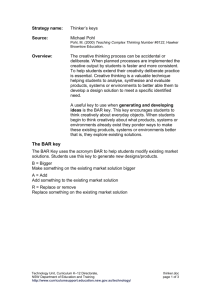Style guide - Curriculum Support
advertisement
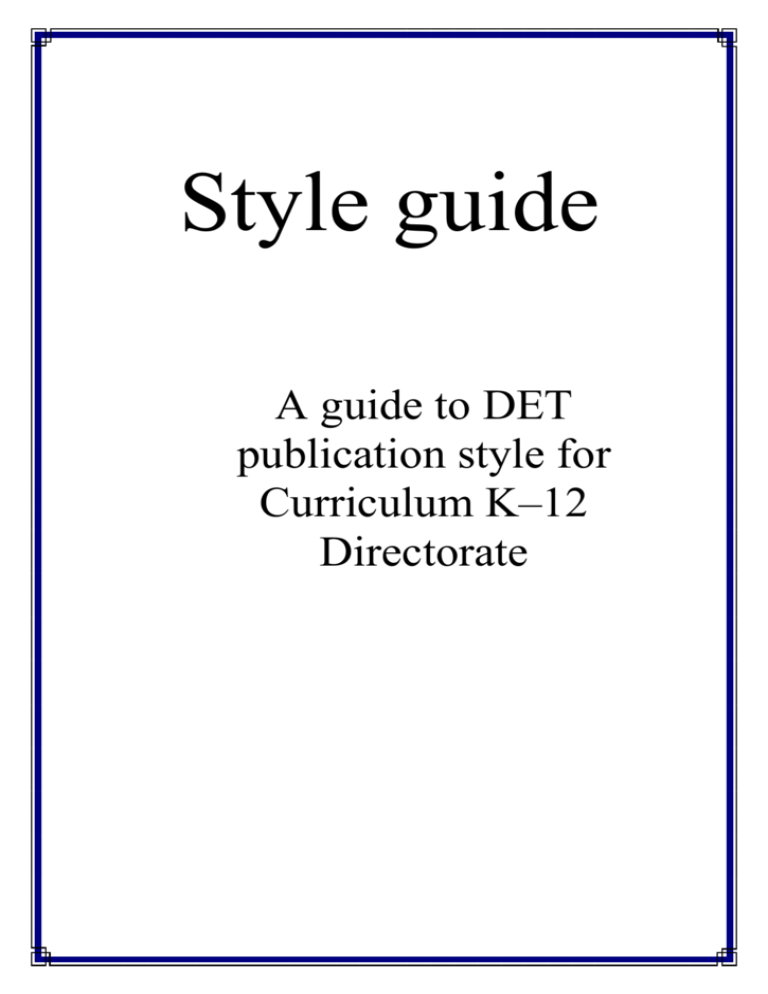
Style guide A guide to DET publication style for Curriculum K–12 Directorate A guide to publication style for Curriculum K–12 Directorate For information regarding the use of this publication contact: Colleen Foley Manager, School Libraries and Information Literacy Curriculum K–12 Directorate Block A, 3a Smalls Rd. Ryde Ph. 02 9886 7488 colleen.foley@det.nsw.edu.au ©2005 Curriculum K–12 Directorate, NSW Department of Education and Training. Revised 2005. SCIS 1204745 Style guide 2 of 19 2 A guide to publication style for Curriculum K–12 Directorate A guide to DET publication style for Curriculum K–12 Directorate Contents General Some hints for writers Adverbs and adverbial phrases Commas Conjunctions Relative pronouns Checklist Abbreviations Accuracy in proofreading Agreement of subject and verb Ambiguity Breaking words Capitals Captions Copyright Dates Headings and subheadings Indicators Lists Non-sexist language Numbers Outcomes Plural and singular Redundancies Spacing Spelling Stages and Years Terminology Titles Syllabus and KLA references Books Trade names Use of examples Use of italics Punctuation Apostrophes Block quotations Brackets Colons Commas Ellipsis Hyphenation Hyphens and dashes Hyphens En rules Em rules Quotation marks Semicolons Slashes Referencing Commonly used words and conventions (including syllabuses) References and further reading Style guide 3 of 19 4 4 4 5 5 5 5 6 6 6 6 6 6 7 7 7 7 8 8 8 8 9 9 9 9 10 10 10 10 10 11 11 11 12 13 13 13 13 13 13 14 14 14 14 14 14 14 15 15 16 17–18 19 3 A guide to publication style for Curriculum K–12 Directorate General The styles discussed here are those of the Directorate. For consistency, observe this style in electronic and printed publications of this Directorate. Remember, a clear structure in a publication benefits the reader. Note that the style used in Ministerial correspondence, The Board of Studies NSW, and some universities may be slightly different from that shown here. For specialised correspondence guidelines see NSW Department of Education and Training (2000) Ministerial correspondence guidelines, viewed 7 February 2005, https://detwww.det.nsw.edu.au/directorates/admiserv/corrbrie/corr_pdf/mini corr.pdf Some hints for writers The following suggestions may help you to write clearly in plain English. Read your writing aloud, this is the best check for making sense. Use active voice. For example, Teachers in government schools must implement Board syllabuses, instead of The implementation of Board syllabuses is mandatory by teachers in government schools. Avoid lumping a series of nouns together, a practice which usually results from the idea that the fewer words you use, the better. This is not always so. The important thing is, what sort of words you use, not how many. Instead of writing, The role that parents play in student learning and literacy development…’ write The role that parents play in helping students to learn and to develop literacy… For lists, use dot points, as dot points usually work better than numbers; for a sub set of dot points, use hyphens. Check to see you make consistent grammatical and semantic sense from the lead-in sentence, for example, that all verbs end in –ing, or –ed. Keep your sentences short. Use no more than two or three clauses (or 30 words maximum) and simple structure (use only one subordinate clause per sentence). If you want readers to take your meaning onboard, less is more. Put only immediately in front of the word it modifies. For example, You can stay here only if you keep very quiet, rather than, You can only stay here… Avoid using not only but also. Keep jargon and acronyms to a minimum. Use punctuation and signposts to guide your reader. The most useful signposts are as follows: Adverbs and adverbial phrases These tell the reader how, when, where or why. For example, later, first, the next day. Style guide 4 of 19 4 A guide to publication style for Curriculum K–12 Directorate Commas Commas are perhaps the most useful of all punctuation marks and can be used to show the parts of your sentence that belong together. It is better to err on the side of giving your reader too much help than to run the risk that your reader will give up because your writing is unduly complex as a result of your parsimony with punctuation especially commas. (See what I mean?) Conjunctions These signal the start of a clause and tell the reader what is coming up: a reason, a time, etc. For example, that, as, because, since, after. It is particularly important not to leave out that when it starts a noun clause. For example, instead of writing, The teacher told the class the new texts would be examined in 2004, write The teacher told the class that the new texts would be examined in 2004. Relative pronouns Include these as they are helpful to the reader: e.g. who, whom, which, that. For example, instead of writing The strategies teachers employ, write The strategies which teachers employ. Checklist Have you: made sure that the document is in keeping with purpose and audience ensured that the document is clearly structured and user friendly read through the finished document, ensuring that it makes sense and that your intention is clear to the reader avoided verbosity and used short sentences and lists checked the grammar and punctuation for accuracy and consistency ensured that the spelling is accurate and follows Australian English conventions kept jargon and acronyms to a minimum recently checked the actual titles of associations, conferences, journal titles, etc. tested that web site addresses reach the specific site mentioned and that the titles of web sites are taken from the screen used this Style guide for assistance with syllabus referencing, commonly used words, bibliographies, etc. Style guide 5 of 19 5 A guide to publication style for Curriculum K–12 Directorate General continued… Abbreviations Do not overuse abbreviations, particularly e.g., i.e. and etc. Do use full stops in these abbreviations. Accuracy in proofreading Careful proofreading by the writer helps an editor retain the intended meaning. The computer’s spelling and grammatical check facility will fail to detect some errors, such as there instead of their, and the use of American English spelling. Check all material submitted for: typing mistakes grammatical errors errors of fact layout errors. Agreement of subject and verb Verbs need to agree with subjects. For example, Teaching and learning are…(not is) A summary of the proposals made in the paper is (not are) reflected in these extracts. Ambiguity Check work to ensure that the reader cannot misinterpret the writer's meaning. A classic example is the famous headline, Eighth Army push bottles up Germans. Breaking words (see also Hyphens in the Punctuation section) Minimise the use of hyphens. Avoid the division of words where possible. Do not use the hyphenation function in word processing or desktop publishing applications. Capitals (see also Titles and Commonly used words) Use capital letters for proper nouns and titles. Minimal capitalisation should be used. Avoid the use of whole words in upper case, AS THEY ARE MUCH HARDER TO READ. Do not use capitals for government if it does not refer to a particular government, for example, government control, an elected government and NSW government schools. It is customary to use Department (and Departmental) when referring to the NSW Department of Education and Training. Our directorate is the Curriculum K–12 Directorate. When referring specifically to the title of a position or an organisation, use capitals as shown in the following: the Director-General of Education and Training the Minister for Education and Training the Premier of New South Wales the Director, Curriculum K–12 the Lord Mayor of Sydney the Director, Baulkham Hills College of TAFE Style guide 6 of 19 6 A guide to publication style for Curriculum K–12 Directorate the Principal of Ballymore High School the Regional Director, Riverina the School Education Director the Head Teacher, English The Chief Education Officer, PDHPE The Senior Curriculum Adviser, Creative Arts Use lower case when referring to the position in a general sense within a sentence. For example, Refer to the principal of your school for further details. In book titles, conference titles, syllabus topics, modules, strands, focus areas, etc., capitalise the first word of the title only and italicise all words in the title. For example, Twelfth night; Pedagogy in practice 2005 conference; Unit 5.6 Design for the future. Use capitals and italics for all words in journal/magazine titles. For example, Curriculum Support, The School Magazine. Use capitals and italics for the titles of Departmental policies. For example, Environmental Education Policy for Schools. Quality Teaching has capitals and italics, however, the full title, Quality teaching in NSW public schools has minimal capitalisation and is all italicised. When Indigenous is used to describe Australians, capitalise the I, for other cultures, lower case i (indigenous) is used. capitalise CD-ROM and DVD capitalise Internet and WebBoard, but use e-book; e-learning; and email. capitalise Term 1 and Semester 2 when used in full and not a generic reference within a sentence. For example, Today students begin a new term and semester. Captions Use captions for all illustrations, diagrams, tables etc. Carefully craft captions so that they are clear and provide maximum information for the reader. Place captions beneath an image or diagram. type in 6 to 8 pt Do not use a full stop after captions that are not complete sentences. Copyright Please observe copyright at all times. For example, if writing teaching activities which direct students to copy and paste from a web site or electronic resource also incorporate a rider or statement reminding teachers about copyright issues and related skill development. Dates write dates as: 6 June 2001 or 6/6/01 the forms: BC (before Christ); BCE (before the Common Era); AD (anno Domini, in the year of our Lord); and CE (Common Era) are all options which may be used. You need to choose the appropriate contexts. For example, 44 BC; 44 BCE; 1066 AD; 1066 CE. Headings and subheadings Using headings benefits the reader by providing a clear structure in a publication. As a general rule, keep headings as brief as possible. A maximum of three levels of heading should be sufficient for most publications. Style guide 7 of 19 7 A guide to publication style for Curriculum K–12 Directorate Use a capital for the first word of a heading only and for proper nouns. For example, Exercises on Shakespeare Topics for discussion There may be some exceptions for literary magazines. Do not use punctuation at the end of a heading, unless it is a question, an exclamation, or an ellipsis. Bold all the words in a clickable link referred to in any document. Bold the chapter headings and subheadings in books and section headings on web sites. Indicators Indicators are usually set as dot points, using a hanging indent. They are not set with capitals and full stops. For example, ENS2.6 identifies issues about the care of places in the community or places of importance to them Lists Use a colon to introduce a list. Do not use punctuation at the end of items in a list, unless the item is a complete sentence in itself. Place a full stop after the last listed item. Items in a list do not begin with upper case, unless the items are extended descriptions, containing one or more complete sentences. For example, each item in a series of teaching activities, described in some detail, should be set with a capital and a full stop. Use dot points or bullet points to indicate each item in the list. For lists within lists, indent, with a dash in front of each point. Non-sexist language Use non-sexist language. Use gender inclusive forms when dealing with functions or occupations designated by words with the suffix man. For example, business executive for businessman gardener for groundsman firefighter for fireman police officer for policeman supervisor for foreman mail carrier for postman, etc. Many of the previously used feminine suffixes are not needed; it is acceptable to use actor for actress, waiter for waitress, poet for poetess, etc. Rewrite phrases such as: a man of letters as an intellectual, scholar or author the best man for the job as the best candidate, or applicant. Problems can occur when using the pronouns, he, she, him, and her. On many occasions, awkwardness can be avoided by recasting the sentence and using their. For example, The student may use their own handwriting. Numbers Write the numbers up to nine in full. For example, one, five, etc. Numbers ten and over should be written as numerals. For example, 10, 21, 159. Do not use numerals to begin or end a sentence. For example, 47 students from North Harbour should be written as Forty-seven students from North Harbour. Style guide 8 of 19 8 A guide to publication style for Curriculum K–12 Directorate Use a space rather than a comma in writing thousands with five or more digits. For example, 31 000 and 456 789. Use $1 billion etc. as opposed to $1 000 million. Minutes should be written as: 29 min. Use a hyphen between the tens and units of a number expressed in words. For example, thirty-seven, and in fractions, two-thirds. Show currency as: A$200 or US$3000. Place a space between numbers and operations in number sentences. For example, 2 + 4 = 6 or 34 x 254 = 8 636 The International System of Units recommends the use of spaces between each group of three numbers. In Europe, a comma indicates the decimal point. Use a full stop in typed text to denote a decimal point. Do not use an apostrophe in years. For example, 1960s, 1990s. Outcomes Generally, write the outcome with a capital to begin and a full stop to end. It is preferred that an outcome be set with a hanging indent. Outcomes are usually set in bold. For example, ENS1.6 Demonstrates an understanding of the relationship between environments and people. Plural and singular The Macquarie dictionary states that data can be singular or plural. Where both singular and plural are to be shown use (s). For example, school(s). use syllabuses not syllabi. Redundancies Try to avoid redundancies. It is easy to fall into the trap of becoming verbose; less is more. Examples of redundancies include: absolute perfection a number of examples appointed to the post of classified into classes general public final completion in abeyance for the time being on the question of a class group. Spacing Word processing does not use double spacing after the full stop. Use tab settings to set spacing. Use the space bar only for spaces between words, as this can cause problems when converting files from one application to another. Style guide 9 of 19 9 A guide to publication style for Curriculum K–12 Directorate Spelling (see also Commonly used words and conventions) Use the spelling given in The Macquarie dictionary. Where alternate spellings are acceptable in the dictionary, use the first spelling listed. Take care to spell official titles of organisations exactly as spelt, even if they are not as recommended in the dictionary. For example, Australian Labor Party The Department has adopted the spelling of program, not programme. Use s rather than z in words like organise and realise. Be aware of trial, trialling and trialled; target, targeted and targeting; and focus and focusing. Stages and Years Use capitals when describing the grade or Stage in which students are taught, such as Kindergarten, Year 3, Year 6, Year 12, Early Stage 1, and Stage 6. When writing about the whole period of primary and secondary schooling, the correct description is K–12. Note the use of an en rule, not a hyphen, to show a range of numbers or years. En rules can be inserted using the keyboard shortcut, (checking that Num lock is on): Windows: alt+0150, Macintosh: Option–hyphen (see Punctuation for more about en rules). Terminology We cannot assume that a reader knows what terms such as ESL, SSPs, ET, ESOL and so on, mean. When using these terms, write them in full for the first time in the document with the abbreviation appearing in brackets. For example, schools for specific purposes (SSPs) English for speakers of other languages (ESOL). The abbreviation can then be used throughout the document. Acronyms are spoken as words and are treated as such. For example, a UNESCO initiative or an SEO1 position. Express computer terms as shown in the latest The Macquarie dictionary. For example, email, Internet, web site, online, computer based, CD-ROM. Preferred terms for institutions, personnel and students The preferred description of a secondary school is a high school. Refer to a school for primary age students as a primary or a public school. The term, central school, is also used. The term used should reflect the wishes of the community. Note, therefore, the form used in the school letterhead. The terms primary school principals and secondary school principals are acceptable. The following TAFE terms are used: institutes colleges campuses institute directors, college directors, campus directors or campus managers. Refer to children attending government schools and TAFE as students. Avoid the use of the word pupils. Titles (see also Capitals, Use of Italics, and Referencing) Style guide 10 of 19 10 A guide to publication style for Curriculum K–12 Directorate Syllabus and KLA references (see also Capitals and Italics and Syllabus conventions) The six key learning areas (KLAs) for primary education are: English Mathematics Science and Technology (ST) (S&T) Human Society and Its Environment (HSIE) Creative Arts Personal Development, Health, and Physical Education (PDHPE) The eight key learning areas (KLAs) for secondary education are: English Mathematics Science Human Society and Its Environment (HSIE) Languages Technology and Applied Studies (TAS) Creative Arts (CA) Personal Development, Health, and Physical Education (PDHPE) Note the use of capitals for the titles of the KLAs. State the course followed by the year to which it refers. For example, Mathematics K–6 syllabus (full title is italicised) Aboriginal Studies Years 7–10 (no italics where the full title is not used) Studies of Religion Stage 6 (no italics where the full title is not used) This allows for use in lists where alphabetical sorting is necessary. Use capitals for syllabus titles but not for the word, syllabus. Use a capital for the name of a subject in a KLA. For example Geography. Note: where space is limited, an ampersand could be used. The abbreviated form, using the initials, is also acceptable. Books The title should be written exactly as it appears on the title page of the publication, with minimum capitals. Use minimal capitalisation in the titles of Curriculum K–12 publications. Choose a title for your publication that indicates the content. The reader should be able to judge the book by its cover. Check with the SCIS team before choosing a title, so that your title is unique. Phone Anne Dowling 9886 7587 to request a SCIS number and ISBN. If using a subtitle, it should be set after the main title, separated by a colon. For example, Reading at home: guidelines for schools. Avoid long titles; use no more than 32 characters. Ensure your designer places the ISBN bar code on the bottom of the back cover of the publication. Trade names Avoid using registered trade names to identify products or things. Examples are ballpoint pen rather than Biro, tissues not Kleenex, and modelling clay not Playdough. Use of examples Style guide 11 of 19 11 A guide to publication style for Curriculum K–12 Directorate Examples can be useful to illustrate a point, but do not overuse them. Do not place examples in brackets. Use of italics (see also Capitals and Titles) italicise titles of books, newspapers and periodicals plays and poems web sites topic/unit titles musical works, musical comedies and operas films and videos paintings, sculptures and the like. exception: song titles are set with single quotation marks and not with italics however, the title of a work containing songs would be set in italics. italicise names of ships, aircraft and other vehicles plants and animals (scientific names) Model, brand and other general names are not italicised. italicise to show emphasis and special sense Show a single word or short phrase quoted, emphasised, used in a special sense or as an example, in italics. italicise foreign words and phrases Italics are preferred over double or single quotation marks for one and two word phrases. italicise acts and other legal documents An act of parliament should be set in italics followed by the jurisdiction, not set in italics, in brackets. For example, Animal Research Act 1985 (NSW). Note: chapter headings, section headings in publications and from web sites, and clickable links in web sites are bolded. Clickable links must be referenced exactly as on web sites but with minimal capitalisation. Style guide 12 of 19 12 A guide to publication style for Curriculum K–12 Directorate Punctuation Apostrophes As a matter of custom, do not use the apostrophe for Sydney Girls High School, Epping Boys High School, or the New South Wales Teachers Federation. Apostrophes are not required for place names such as Batemans Bay or St Georges Basin. Check to ensure appropriate use in names of organisations. For example, NSW Primary Principals’ Association. Do not use apostrophes in abbreviations, such as RMLs or the 1970s. Block quotations Quotations of more than two sentences should be set as separate passages, and introduced by a colon. Indent on the left and set one point smaller in size, or in italics. Quotation marks are not required when set this way. For poetry, indent when two or more lines are quoted. The reference or author should be justified right, on the line below the block quote. Brackets Minimise use. Use brackets only as necessary to enclose an expression that is not essential to the meaning of the sentence, but which amplifies, clarifies, or is an aside. Colons The typical use of the colon includes: a list within the sentence or set off from the text. For example, The book was of interest to a wide range of people: librarians, journalists, editors, and teachers. The ingredients are:…. Do not use a colon in a sentence when the list is introduced by: for example including such as that is namely, and so on, unless the list is set off from the text. Use a colon for dialogue and play scripts. For example, Mary: Where are my glasses? No capital letter is necessary in a heading with a follow-on subheading, such as Quality teaching in NSW public schools: modelling the model. Commas Use punctuation for pause and effect and to make the statement clear. Where clauses are short and linked by the word and the comma can usually be omitted. For example, The wind was strong and the rain was heavy. Commas should be used between coordinate clauses that have different subjects and are linked by conjunctions such as but, for, and nor. For example, The price of strawberries dropped, but apples were dearer. Note: however is usually preceded by a semicolon or a full stop and is always followed by a comma. Style guide 13 of 19 13 A guide to publication style for Curriculum K–12 Directorate Avoid starting sentences with however. Ellipsis Ellipsis marks an omission in quoted text or a faltering in speech. Only three dots are used with a space before and a space after. Don’t use full stops. Note: Macintosh: Option+semicolon displays an…; Windows: Alt+Ctrl+… Hyphenation Use the style recommended by The Macquarie dictionary. Exceptions to this are where the meaning needs to be differentiated. For example, re-form and reform. Use the hyphen where the prefix joined to the base will result in a double vowel. For example, anti-intellectual and when the base word has a capital. For example, pre-Christian Do not hyphenate cooperate, cooperative, coordinate, and coordinator. Hyphens and dashes There are three symbols in common use in publishing: hyphens; en rules; and em rules. Hyphens (see also Hyphenation) Use hyphens (the shortest in length, with no spacing) to mark breaks in words or to link prefixes to other words. Check the spelling used in the The Macquarie dictionary. En rules These are used to link discrete items. For example, 1939–45 pp. 306–7 Commonwealth–State agreement hand–eye coordination 1–2-day-old chickens. As a rule of thumb, an en rule generally takes the place of a preposition, as in K– 6; 7–10. Windows: alt+0150 numeric pad, Macintosh: Option–hyphen. Em rules (dash) Em rules indicate a parenthetical statement inserted in a sentence, or an abrupt change in thought. Do not use em rules in place of more appropriate punctuation, such as commas and colons. There should be no space between the dash and other words. For example, Students will not cope comfortably with too many instructions—two or three would be preferred, and, No one—you guessed it—stepped forward. Windows: alt+0151 numeric pad, Macintosh: Option shift hyphen. Quotation marks (see also Use of italics and Block quotations) Use single quotation marks when reporting direct speech. Use double quotation marks for a quotation within a quotation. Style guide 14 of 19 14 A guide to publication style for Curriculum K–12 Directorate Semicolons The semicolon separates parts of a sentence that require a stronger break than that marked by a comma, but are too closely related to be broken into a separate sentence. Slashes Avoid using slashes. For example, instead of his/hers, use and or or instead of Sydney/Brisbane flight, use Sydney–Brisbane flight. Try to avoid the use of and/or. Style guide 15 of 19 15 A guide to publication style for Curriculum K–12 Directorate Referencing A reference list consists solely of publications cited by the author. A bibliography contains references, as well as uncited publications considered by the author to be relevant to the topic. Reference lists should always be set in alphabetical order by author. When setting a list of references, indent the second line to emphasise the author. There are several referencing systems in use; for consistency in Departmental publications, the following formats are recommended: Journal articles Mason, W. (2004) ‘Continuing the focus on pedagogy’, Scan 23(1), pp. 34–35. Books Truss, L. (2003) Eats, shoots & leaves: the zero tolerance approach to punctuation, Profile, London. Conference papers Todd, R. (2003) ‘Learning in the information age school: opportunities, outcomes and options’ keynote paper presented at the International Association of School Librarianship (IASL) 2003 annual conference, Durban, South Africa, 7–11 July. Internet Provide as much information as possible when referring to an Internet address (URL), including: name and place of the sponsor of the source site date – the date the site was created or last revised author – the person or organisation responsible for the site title (exactly as shown on the front page or, ideally, in the SCIS record) date of viewing the source URL – bolded This is an example of referencing an Internet site in a reference list or bibliography: Curriculum K–12 Directorate, NSW Department of Education and Training (2003) Quality Teaching, viewed 13 January 2005, http://www.curriculumsupport.nsw.edu.au/qualityTeaching/index.cfm Reports Time to teach – time to learn: report on the evaluation of outcomes assessment and reporting in NSW government schools, (2003) NSW Department of Education and Training. Sydney. Syllabuses English K–6 syllabus (1998) Board of Studies NSW, Sydney. For further details, refer to: Style guide 16 of 19 16 A guide to publication style for Curriculum K–12 Directorate Style manual for authors, editors and printers (2002) 6th ed., John Wiley & Sons, Australia. Commonly used words and conventions Aboriginal people, not Aborigines Aboriginal Australian, aboriginal others artform Board of Studies NSW (BOS) CD-ROM cooperate coordinate credentialed, credentialling cross-curriculum database e-book, e-learning, email, e-zine follow-up face-to-face focusing Google indepth Internet, intranet ICT not technology learn about and learn to in italics metacognitive Microsoft Word multistage non government, non English nonfiction NSW Primary Principals’ Association NSW Secondary Principals’ Council ongoing online outcomes based pre 1900 pdf PowerPoint print based problem-solving program Quality Teaching Quality teaching in NSW public schools. [note: bold and capitalise the first letter of the dimensions of Quality Teaching e.g. Significance. Bold the elements of Quality Teaching e.g. deep knowledge; metalanguage, etc. Do not capitalise the first letter unless the word is at the beginning of a sentence.] real-life school based School Based Assessment Unit socioeconomic statewide step by step Style guide 17 of 19 17 A guide to publication style for Curriculum K–12 Directorate Stolen Generation syllabuses, not syllabi targeted, targeting timeslot trialled, trialling up-to-date USA, NSW warm up web based WebBoard WebQuest web site whole schools. Syllabus conventions Style guide Note use of en rule, and when to use italics in the following examples. Italicise the title when written in full, do not italicise when it is a generic reference. For example, Commerce 7–10 Commerce Years 7–10 syllabus the Commerce syllabus Business Studies Stage 6 syllabus German Stage 6: Beginners; Continuers; Extension (note that the semi colon is not italicised) Area of Study: The journey Economics Stage 6 syllabus topic, Consumers and business 18 of 19 18 A guide to publication style for Curriculum K–12 Directorate References and further reading Australian Government, Information Management Office Style manual for authors, editors and printers (1994), viewed 7 February 2005, http://www.agimo.gov.au/information/publishing/style_manual (note: now superseded by Style manual 6th edition: see details at http://www.agimo.gov.au/information/publishing) The Macquarie dictionary rev. 3rd ed (2001) Delbridge (ed.), Macquarie Library, Sydney. The Penguin working words: an Australian guide to modern English usage (1995) Hughes (ed.) Penguin, Ringwood. Style manual for authors, editors and printers (2002) 6th ed., John Wiley & Sons, Australia. Truss, L. (2003) Eats, shoots & leaves: the zero tolerance approach to punctuation, Profile, London. Style guide 19 of 19 19
